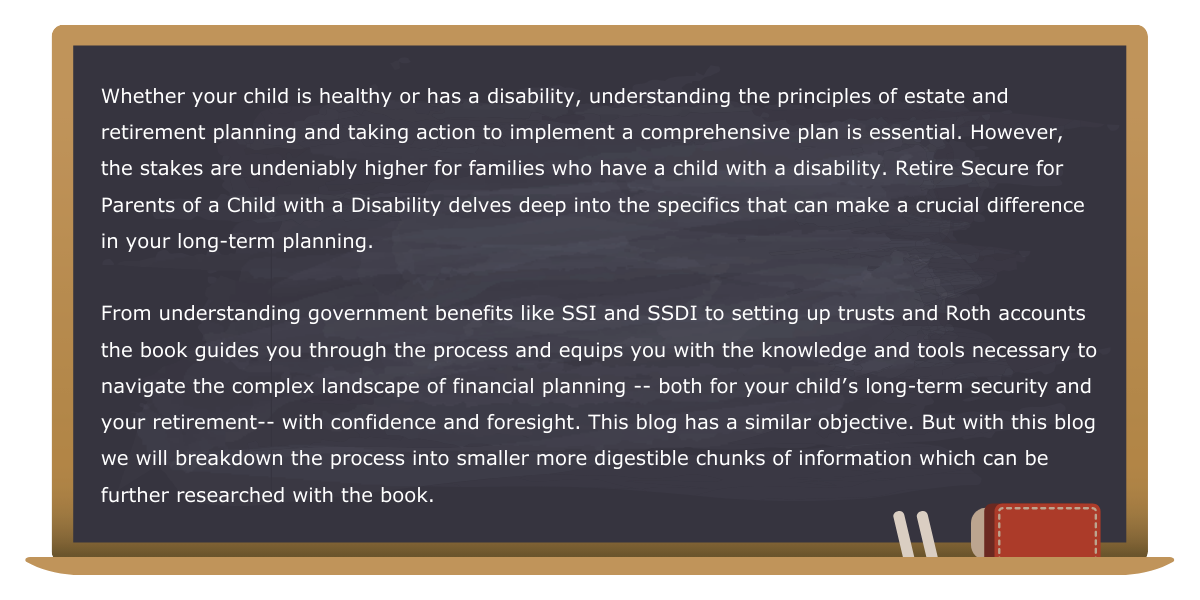Blog for Parents of a Child with a Disability

Minimize Your Life Insurance Costs to Maximize Your Retirement Contributions: The Ladder Approach
General Introduction
The objective of term life insurance is to protect a family from the financial devastation that can ensue from the untimely death of a primary bread winner(s). It is also important to insure the value of the services of a stay-at-home parent. It is critically important insurance, but it is also to your advantage to try to get the appropriate level of coverage for the most reasonable price.
One of the most common mistakes my younger clients make is not having sufficient term insurance. Most healthy young people survive until retirement age and paying for term insurance is not something anyone really wants to do. But, you have to plan for unfortunate events. In my experience, it is rarely the result of a catastrophic car or plane accident, but more frequently because of the sudden onset of cancer or some other fatal disease.
The key is to find a policy that balances adequate insurance and minimum premiums. I do not like to see people, especially younger people who are working on a limited budget, pay high life insurance premiums.
The best way to start thinking about how much life insurance you need is to consider “How much income will your survivors require to live comfortably?”

A Ballpark Way to Calculate How Much Life Insurance You Might Need
Let’s say that after some analysis, you decide that an appropriate income is $60,000 per year in today’s dollars.
I am not going to delve into the intricacies of calculating a safe withdrawal rate—that is to say, how much as a percentage of principal you can withdraw and have the money last for a lifetime—but I would say for young people with a long-life expectancy, 4% would probably be on the high side for a safe withdrawal rate. This means if there is no other source of income, an individual will need at least $1,500,000 of life insurance ($60,000/4% = $1,500,000).
First, I hope I didn’t just bum you out and make you realize you are vastly underinsured because $60,000 of income doesn’t sound that high, and you do not have anywhere near $1,500,000 of insurance. Admittedly, whatever resources you have can be used to reduce the need for life insurance. If both spouses work, the income of the survivor can certainly be factored in. If you have significant investments or savings, they can also be used to reduce the need for insurance.
Permanent Insurance VS. Term Insurance
Permanent insurance is a type of policy that ultimately has cash value. There is a payout when you die, or sometimes upon reaching a certain age. Term insurance, on the other hand, at least the way I use it, will likely not pay out if you survive to a normal life expectancy. It is designed to protect your heirs if you do not survive to a normal life expectancy.
Permanent insurance is expensive, so many families who like the idea that there will always be a payout in the future go ahead and buy permanent insurance. They are usually woefully unprotected at the insurance premium levels they can afford.
Term insurance is less expensive, so when cost is an issue, which it nearly always is for younger families, I recommend considering laddered term insurance to help keep premiums more affordable but to also provide you with sufficient protection. Even though you give up a permanent benefit, I would rather see the money going toward sufficient term insurance, so the surviving spouse and other family members are protected rather than having a permanent policy but with an insufficient amount of coverage.
Let’s assume that you do projections and determine that you will have sufficient money to retire at age 60 (assuming you are age 30 now). You might logically think—as premiums are guaranteed never to go up—“Okay, I need a 30-year level term policy for $1,500,000.”
If you work and save for ten years, you may only need $1,000,000 at that point in time. Perhaps in the ten years beyond that, your need may drop to $500,000. I am trying to keep it simple to make a point. The point is as you age, your insurance needs will change, usually getting smaller, and thinking within this more flexible framework offers some new options.
Since I am being frugal with your insurance budget, consider the following set of policies, assuming the above situation.
- Get a 30-year term policy for $500,000 coverage
- Get a 20-year term policy for $500,000 coverage
- Get a 10-year term policy for $500,000 coverage
If you die between the date the policy is issued and year ten, your heirs get $1,500,000, which is what we determined was the needed amount. At the end of ten years, the first policy ends, and you will only have $1,000,000 of coverage. That is okay. By this point you should have $500,000 in retirement plans and savings. In addition, the need for insurance will be down a little bit because your heirs will have a shorter life expectancy.
After 20 years, the second policy ends, and you will only have $500,000 of coverage remaining. That is okay because by this time you should have $1,000,000 of retirement and savings, and your need will only be $500,000. At the end of 30 years, you will have no coverage, but again, that is okay because hopefully by then you will have accrued sufficient resources for your surviving spouse.
Of course, in the above example, I have kept things really simple. I have not included relevant factors like inflation, children’s true needs, timing of education needs, the ability of the surviving spouse to work, and so forth. But you get the idea.
After you decide to get the insurance you need, I recommend purchasing your insurance through an ethical insurance broker (someone who can purchase insurance from many different companies). In our experience, working with a broker is the way to get the best policies at the best rates.
Consider Adding a Small Permanent Policy to the Mix
When considering term insurance, a key consideration should be the policy’s conversion features. Conversion features provide additional flexibility in case your insurance requirements change in the future. Suppose you become uninsurable due to health issues, or you decide you need coverage for a longer period. Without conversion options, you might have to buy a new policy with a higher premium because you’re older and likely have medical issues or—worst case scenario—those options may be unavailable.
Conversion options allow you to convert to an insurance company’s ‘permanent’ product without medical underwriting at the same rate class as you were originally approved. Most insurance companies have an expensive conversion feature, but some insurance companies offer conversions to any product available in their portfolio at the time of conversion. Having the option to convert to the lowest cost product available can be a game changer as we get older and medical issues begin to arise.
Also, it might be wise to consider a permanent life insurance policy with a chronic care rider and/or a second-to-die policy when planning long term for a child with a disability.
Conclusion
We will cover additional insurance topics in future blogs, but this provides a broad overview and justification for the urgency to have adequate life insurance to protect a family from the possible, if even unlikely, consequences of a tragedy.
If you are immediately in need of more information please see Chapter 13, Special Needs Trusts and Legal Considerations for Children with Disabilities for protecting your child with a disability with a special needs trust funded with life insurance. For more information on how to get the best deal on life insurance, and how to use life insurance as a tool to protect your family and your child with a disability after you die, be sure to read Chapter 26, Life Insurance as an Estate Planning Tool, in RSPCD.

